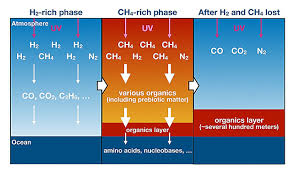Unlocking Earth's Secrets: New Model Explores the Atmosphere and Origins of Life

Research teams from Tohoku University, the University of Tokyo, and Hokkaido University have crafted a groundbreaking model to decipher how the atmosphere—and the earliest signs of life—evolved on Earth. Shungo Koyama from Tohoku University explains, "Ancient Earth was nothing like our current home. It was a much more hostile environment, rich in metallic iron and characterized by an atmosphere laden with hydrogen and methane."
These molecular compounds hold essential clues to the origins of life. When exposed to solar ultraviolet (UV) radiation, they engage in chemical reactions that yield organic compounds, which serve as the fundamental building blocks of life. Among these organic compounds are precursors to vital biomolecules, including amino acids and nucleic acids.
However, understanding the impact of UV radiation on these early atmospheric conditions presents challenges. The atmosphere of ancient Earth was likely unstable and subject to rapid fluctuations due to various atmospheric chemical reactions. Additionally, UV radiation breaks down water vapor, creating oxidative molecules, but the specific branching ratios and timescales of these reactions remain uncertain.
To tackle these complexities, the researchers developed a one-dimensional photochemical model to accurately simulate the ancient Earth’s atmosphere. Their calculations revealed that most hydrogen escaped into space while hydrocarbons like acetylene, produced from methane, acted as a shield against UV radiation. This shielding effect significantly reduced the breakdown of water vapor and the subsequent oxidation of methane, thereby enhancing the production of organics.
Tatsuya Yoshida of Tohoku University suggests, "If the initial amount of methane was comparable to the carbon content found on present-day Earth’s surface, organic layers several hundred meters thick could have formed. This could have led to the accumulation of organics, creating an enriched ‘soup’ of essential building blocks from which life may have first emerged."
Interestingly, the model indicates that the atmosphere of ancient Earth bore striking similarities to the conditions we observe on neighboring planets, Venus and Mars. Despite their proximity, Earth has developed into a vastly different environment, prompting researchers to explore what sets our planet apart. This model not only enhances our understanding of Earth's atmospheric evolution but also raises questions about the common patterns shared by other planetary systems in their journey toward life.
The findings contribute valuable insights into whether the atmospheric evolution and origins of life on Earth are unique or if they resonate with processes occurring elsewhere in the cosmos.
Story Source:
Materials provided by Tohoku University. The original text of this story is licensed under a Creative Commons License. Note: Content may be edited for style and length.
Journal Reference:
- Tatsuya Yoshida, Shungo Koyama, Yuki Nakamura, Naoki Terada, Kiyoshi Kuramoto. Self-Shielding Enhanced Organics Synthesis in an Early Reduced Earth’s Atmosphere. Astrobiology, 2024; DOI: 10.1089/ast.2024.0048

0 Comments